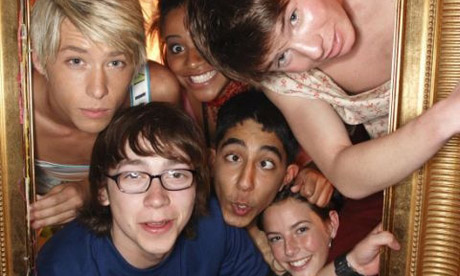- Representation refers to the construction in any medium (especially the mass media) of aspects of ‘reality’ such as people, places, objects, events, cultural identities and other abstract concepts. Such representations may be in speech or writing as well as still or moving pictures.
Thursday 21 May 2009
Thursday 14 May 2009


How are young people represented in the media???
- On the television teenagers are put across as bad people: carrying knives, drinking illegally and generally causing trouble for other people and themselves. Most people know that this isn't a fair representation of the issues most young people go through. In our experience, young people are more likely to be concerned about their emotions, their relationships, bullying, sexuality and self-harm than they are to drink illegally, mug people or make lives difficult for other people!
Friday 1 May 2009
Meanings of these keywords:
Mise-en-scene
Verisimilitude
Social Realism
Diegetic Sound
Non-diegetic Sound
Editing

Mise-en-scene
Verisimilitude
Social Realism
Diegetic Sound
Non-diegetic Sound
Editing

Mise-en-scene: (Realistic) technique whereby meaning is conveyed through the relationship of things visible within a single shot. An attempt is preserve space and time as much as possible, editing or fragmenting of scenes is minimised. Composition is therefore extremely important!


Verisimilitude: Verisimilitude in its literary context is defined as the fact or quality of being verisimilar, the appearance of being true or real; likeness or resemblance of the truth, reality or a fact's probability. Verisimilitude comes from Latin verum meaning truth and similis meaning similar.


Social Realism: Social Realism, also known as Socio-Realism, is an artistic movement, expressed in the visual and other realist arts, which depicts social and racial injustice, economic hardship, through unvarnished pictures of life's struggles; often depicting working class activities as heroic.


Diegetic Sound: is any sound presented as originated from source within the film's world; Digetic sound can be either on screen or off screen depending on whatever its source is within the frame or outside the frame. Another term for diegetic sound is actual sound.


Non - Diegetic Sound: is represented as coming from the a source outside story space; another term for non-diegetic sound is commentary sound. The distinction between diegetic or non-diegetic sound depends on our understanding of the conventions of film viewing and listening. We know of that certain sounds are represented as coming from the story world, while others are represented as coming from outside the space of the story events. A play with diegetic and non-diegetic conventions can be used to create ambiguity (horror), or to surprise the audience (comedy).


Editing: is the process of preparing language, images, sound, video, or film through correction, condensation, organization, and other modifications in various media. A person who edits is called an editor. In a sense, the editing process originates with the idea for the work itself and continues in the relationship between the author and the editor. Editing is, therefore, also a practice that includes creative skills, human relations, and a precise set of methods
Subscribe to:
Posts (Atom)

